Danny Kaye
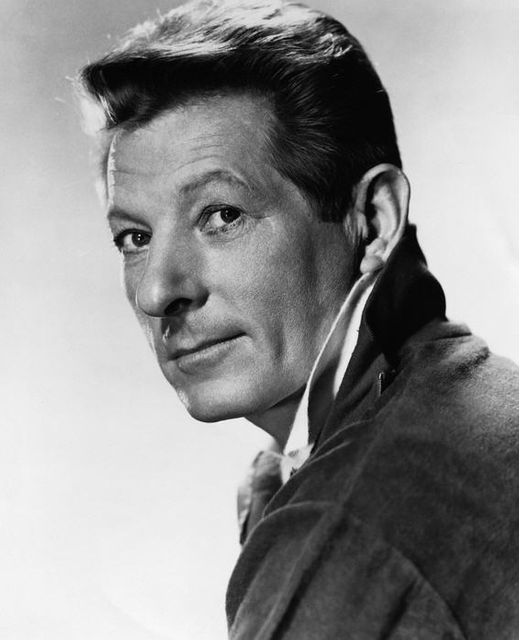
Danny Kaye

Danny Kaye | |
|---|---|
| Born | David Daniel Kaminsky (1911-01-18)January 18, 1911 Brooklyn, New York, U.S. |
| Died | March 3, 1987(1987-03-03)(aged 76) Los Angeles, California, U.S. |
| Occupation |
|
| Years active | 1933–1986 |
| Spouse(s) | Sylvia Fine (m. 1940) |
| Children | 1 |
| Website | dannykaye.com [128] |
Danny Kaye (born David Daniel Kaminsky; Yiddish: דאַװיד דאַניעל קאַמינסקי; January 18, 1911 – March 3, 1987) was an American actor, singer, dancer, comedian, musician, and philanthropist. His performances featured physical comedy, idiosyncratic pantomimes, and rapid-fire novelty songs.
Kaye starred in 17 movies, notably Wonder Man (1945), The Kid from Brooklyn (1946), The Secret Life of Walter Mitty (1947), The Inspector General (1949), Hans Christian Andersen (1952), White Christmas (1954), and The Court Jester (1956).
His films were popular, especially for his performances of patter songs and favorites such as "Inchworm" and "The Ugly Duckling." He was the first ambassador-at-large of UNICEF in 1954 and received the French Legion of Honour in 1986 for his years of work with the organization.[1]
Danny Kaye | |
|---|---|
| Born | David Daniel Kaminsky (1911-01-18)January 18, 1911 Brooklyn, New York, U.S. |
| Died | March 3, 1987(1987-03-03)(aged 76) Los Angeles, California, U.S. |
| Occupation |
|
| Years active | 1933–1986 |
| Spouse(s) | Sylvia Fine (m. 1940) |
| Children | 1 |
| Website | dannykaye.com [128] |
Early years
David Daniel Kaminsky was born in Brooklyn, New York, on January 18, 1911 (though he would later say 1913),[2][3][4][5] to Ukrainian Jewish immigrants Jacob and Clara (née Nemerovsky) Kaminsky. He was the youngest of three sons. Jacob and Clara and their older sons Larry and Mac left Dnipropetrovsk two years before Danny's birth; he was their only son born in the United States.[6]
His mother died when he was in his early teens. Not long after his mother's death, Kaye and his friend Louis ran away to Florida. Kaye sang while Louis played the guitar and the pair eked out a living for a while. When Kaye returned to New York, his father did not pressure him to return to school or work, giving his son the chance to mature and discover his own abilities.[10] Kaye said that as a young boy, he had wanted to be a surgeon, but the family could not afford a medical education.[6][11]
He held a succession of jobs after leaving school, as a soda jerk, auto insurance investigator, and office clerk. Most ended with his being fired. He lost the insurance job when he made an error that cost the insurance company $40,000 ($600,000 in 2019 adjusted for inflation)[12]. A dentist who hired him to look after his office over lunch and run errands also fired him when he found Kaye using his dental drill on the office woodwork. In 1939, Kaye met the dentist's daughter, Sylvia Fine at an audition and in 1940 they eloped.[13][6][14] He learned his trade in his teenaged years in the Catskills as a tummler in the Borscht Belt.[8]
The troupe left for a six-month tour of the Far East on February 8, 1934. While they were in Osaka, Japan, a typhoon hit the city. The hotel where Kaye and his colleagues stayed suffered heavy damage. The strong wind hurled a piece of the hotel's cornice into Kaye's room; had he been hit, he might well have been killed. By performance time that evening, the city was in the grip of the storm. With no power, the audience became restless and nervous. To calm them, Kaye went on stage holding a flashlight to illuminate his face and sang every song he could recall as loudly as he was able.[6]
The experience of trying to entertain audiences who did not speak English inspired him to the pantomime, gestures, songs, and facial expressions that eventually made his reputation.[8][14] Sometimes, he found pantomime necessary when ordering a meal. Kaye's daughter, Dena, tells a story her father related about being in a restaurant in China and trying to order chicken. Kaye flapped his arms and clucked, giving the waiter an imitation of a chicken. The waiter nodded in understanding, bringing Kaye two eggs. His interest in cooking began on the tour.[8][15]
Jobs were in short supply when Kaye returned to the United States, and he struggled for bookings. One job was working in a burlesque revue with fan dancer Sally Rand. After the dancer dropped a fan while trying to chase away a fly, Kaye was hired to watch the fans so they were always held in front of her.[8][14]
Career
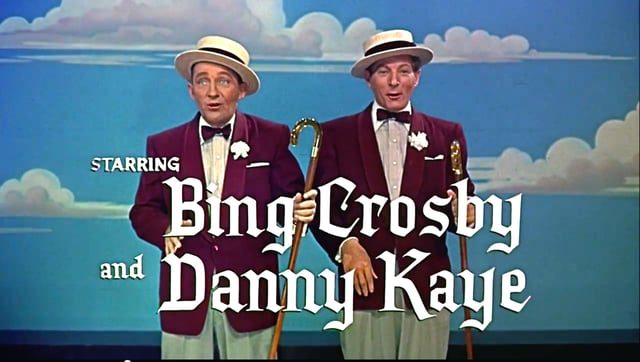
White Christmas trailer
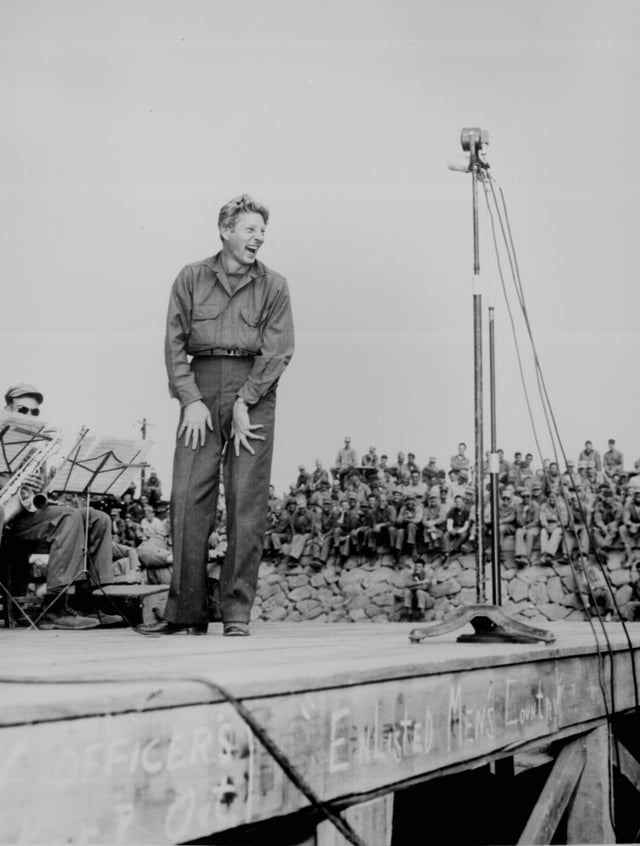
Danny Kaye on USO tour at Sasebo, Japan, October 25, 1945. Kaye and his friend, Dodgers manager Leo Durocher, made the trip.[27]
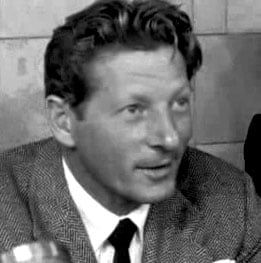
Kaye at Schiphol on October 5, 1955
Danny Kaye made his film debut in a 1935 comedy short Moon Over Manhattan. In 1937, he signed with New York–based Educational Pictures for a series of two-reel comedies. He usually played a manic, dark-haired, fast-talking Russian in these low-budget shorts, opposite young hopefuls June Allyson and Imogene Coca. The Kaye series ended abruptly when the studio shut down in 1938. He was working in the Catskills in 1937 under the name Danny Kolbin.[16][17]
His next venture was a short-lived Broadway show with Sylvia Fine as the pianist, lyricist, and composer. The Straw Hat Revue opened on September 29, 1939, and closed after 10 weeks, but critics took notice of Kaye's work.[6][18] The reviews brought an offer for both Kaye and his bride Sylvia to work at La Martinique, a New York City nightclub. Kaye performed with Sylvia as his accompanist. At La Martinique, playwright Moss Hart saw Danny perform, and that led to Hart's casting him in his hit Broadway comedy Lady in the Dark.[6][14]
Kaye scored a triumph at age 30 in 1941 playing Russell Paxton in Lady in the Dark, starring Gertrude Lawrence. His show-stopping number was "Tchaikovsky" by Kurt Weill and Ira Gershwin in which he sang the names of a string of Russian composers at breakneck speed, seemingly without taking a breath.[19][20] In the next Broadway season, he was the star of a show about a young man who is drafted called Let's Face It!.[21]
His feature-film debut was in producer Samuel Goldwyn's Technicolor 1944 comedy Up in Arms, a remake of Goldwyn's Eddie Cantor comedy Whoopee! (1930).[22] Rival producer Robert M. Savini cashed in by compiling three of Kaye's Educational Pictures shorts into a patchwork feature entitled The Birth of a Star (1945). Studio mogul Goldwyn wanted Kaye's prominent nose fixed to look less Jewish,[23][24] Kaye refused, but he did allow his red hair to be dyed blond, apparently because it looked better in Technicolor.[24]
Kaye starred in a radio program, The Danny Kaye Show, on CBS in 1945–46.[25] The program's popularity rose quickly. Before a year, he tied with Jimmy Durante for fifth place in the Radio Daily popularity poll.[14] Kaye was asked to participate in a USO tour following the end of World War II. It meant that he would be absent from his radio show for nearly two months at the beginning of the season. Kaye's friends filled in, with a different guest host each week.[26] Kaye was the first American actor to visit postwar Tokyo. He had toured there some 10 years before with the vaudeville troupe.[27][28] When Kaye asked to be released from his radio contract in mid-1946, he agreed not to accept a regular radio show for one year and only limited guest appearances on other radio programs.[26][29] Many of the show's episodes survive today, notable for Kaye's opening "signature" patter ("Git gat gittle, giddle-di-ap, giddle-de-tommy, riddle de biddle de roop, da-reep, fa-san, skeedle de woo-da, fiddle de wada, reep!").[14]
Kaye starred in several movies with actress Virginia Mayo in the 1940s and is known for films such as The Secret Life of Walter Mitty (1947), The Inspector General (1949), On the Riviera (1951) co-starring Gene Tierney, Knock on Wood (1954), White Christmas (1954), The Court Jester (1956), and Merry Andrew (1958). Kaye starred in two pictures based on biographies, Hans Christian Andersen (1952) the Danish storyteller and The Five Pennies (1959) about jazz pioneer Red Nichols. His wife, writer/lyricist Sylvia Fine, wrote many tongue-twisting songs for which Kaye became famous.[11][30] She was also an associate film producer.[31] Some of Kaye's films included the theme of doubles, two people who look identical (both Danny Kaye) being mistaken for each other to comic effect[32].
While his wife wrote most of Kaye's material, he created much of it himself, often while performing. Kaye had one character he never shared with the public; Kaplan, the owner of an Akron, Ohio, rubber company, came to life only for family and friends. His wife, Sylvia, described the Kaplan character:[33]
He doesn't have any first name. Even his wife calls him just Kaplan. He's an illiterate, pompous character who advertises his philanthropies. Jack Benny or Dore Schary might say, "Kaplan, why do you hate unions so?" If Danny feels like doing Kaplan that night, he might be off on Kaplan for two hours.
When he appeared at the London Palladium in 1948, he "roused the Royal family to laughter and was the first of many performers who have turned British variety into an American preserve." Life magazine described his reception as "worshipful hysteria" and noted that the royal family, for the first time, left the royal box to watch from the front row of the orchestra.[34][35][36] He related that he had no idea of the familial connections when the Marquess of Milford Haven introduced himself after a show and said he would like his cousins to see Kaye perform.[20] Kaye stated he never returned to the venue because there was no way to recreate the magic of that time.[37] Kaye had an invitation to return to London for a Royal Variety Performance in November of the same year.[38]
When the invitation arrived, Kaye was busy with The Inspector General (which had a working title of Happy Times). Warner Bros. stopped the film to allow their star to attend.[39] When his Decca co-workers the Andrews Sisters began their engagement at the London Palladium on the heels of Kaye's successful 1948 appearance there, the trio was well received and David Lewin of the Daily Express declared: "The audience gave the Andrews Sisters the Danny Kaye roar!"[40]
He hosted the 24th Academy Awards in 1952. The program was broadcast on radio. Telecasts of the Oscar ceremony came later. During the 1950s, Kaye visited Australia, where he played Buttons in a production of Cinderella in Sydney. In 1953, Kaye started a production company, Dena Pictures, named for his daughter. Knock on Wood was the first film produced by his firm. The firm expanded into television in 1960 under the name Belmont Television.[41][42]
Kaye entered television in 1956, on the CBS show See It Now with Edward R. Murrow.[43] The Secret Life of Danny Kaye combined his 50,000-mile, ten-country tour as UNICEF ambassador with music and humor.[44][45] His first solo effort was in 1960 with a one=hour special produced by Sylvia and sponsored by General Motors, with similar specials in 1961 and 1962.[6]
Beginning in 1964, he acted as television host to the CBS telecasts of MGM's The Wizard of Oz. Kaye did a stint as a What's My Line? mystery guest on the Sunday-night CBS-TV quiz program. Kaye was later a guest panelist on that show. He also appeared on the interview program Here's Hollywood. In the 1970s, Kaye tore a ligament in his leg during the run of the Richard Rodgers musical Two by Two, but went on with the show, appearing with his leg in a cast and cavorting on stage in a wheelchair.[46][48] He had done much the same on his television show in 1964, when his right leg and foot were burned from a cooking accident. Camera shots were planned so television viewers did not see Kaye in his wheelchair.[49]
In 1976, he played Mister Geppetto in a television musical adaptation of Pinocchio with Sandy Duncan in the title role. Kaye portrayed Captain Hook opposite Mia Farrow in a musical version of Peter Pan featuring songs by Anthony Newley and Leslie Bricusse. He later guest-starred in episodes of The Muppet Show and The Cosby Show,[50] and in the 1980s revival New Twilight Zone.
In many films, as well as on stage, Kaye proved to be an able actor, singer, dancer, and comedian. He showed his serious side as ambassador for UNICEF and in his dramatic role in the memorable TV film Skokie, when he played a Holocaust survivor.[46] Before his death in 1987, Kaye conducted an orchestra during a comical series of concerts organized for UNICEF fundraising. Kaye received two Academy Awards: an Academy Honorary Award in 1955 and the Jean Hersholt Humanitarian Award in 1982. That year he received the Screen Actors Guild Annual Award.[19]
Career in music

Singer Nancy Wilson appearing on his show in 1965
Kaye was enamored of music. While he claimed an inability to read music, he was said to have perfect pitch. A flamboyant performer with his own distinctive style, "easily adapting from outrageous novelty songs to tender ballads" (according to critic Jason Ankeny), in 1945, Kaye began hosting his own CBS radio program, launching a number of hit songs including "Dinah" and "Minnie the Moocher."[53]
In 1947, Kaye teamed with the popular Andrews Sisters (Patty, Maxene, and LaVerne) on Decca Records, producing the number-three Billboardhit "Civilization (Bongo, Bongo, Bongo)". The success of the pairing prompted both acts to record through 1950, producing rhythmically comical fare as "The Woody Woodpecker Song" (based on the bird from the Walter Lantz cartoons and a Billboard hit for the quartet), "Put 'em in a Box, Tie 'em with a Ribbon (And Throw 'em in the Deep Blue Sea)", "The Big Brass Band from Brazil", "It's a Quiet Town (In Crossbone County)", "Amelia Cordelia McHugh (Mc Who?)", "Ching-a-ra-sa-sa", and a duet by Danny and Patty Andrews of "Orange Colored Sky". The acts teamed for two yuletide favorites: a frantic, harmonic rendition of "A Merry Christmas at Grandmother's House (Over the River and Through the Woods)" and a duet by Danny and Patty, "All I Want for Christmas Is My Two Front Teeth".[40]
Kaye's debut album, Columbia Presents Danny Kaye, had been released in 1942 by Columbia Records with songs performed to the accompaniment of Maurice Abravanel and Johnny Green. The album was reissued as a Columbia LP in 1949 and is described by the critic Bruce Eder as "a bit tamer than some of the stuff that Kaye hit with later in the '40s and in the '50s and, for reasons best understood by the public, doesn't attract nearly the interest of his kids' records and overt comedy routines."[54]
Following the success of the film Hans Christian Andersen (1952), two of its songs written by Frank Loesser and sung by Kaye, "The Ugly Duckling" and "Wonderful Copenhagen", reached the top five on the UK pop charts.[53] In 1953, Decca released Danny at the Palace, a live recording made at the New York Palace Theater,[56] followed by Knock On Wood (Decca, 1954) a set of songs from the movie of the same name sung by Kaye, accompanied by Victor Young and His Singing Strings.[57]
In 1956, Kaye signed a three-year recording contract with Capitol Records, which released his single "Love Me Do" in December of that year.[58] The B-side, "Ciu Ciu Bella", with lyrics written by Sylvia Fine, was inspired by an episode in Rome when Kaye, on a mission for UNICEF, befriended a 7-year-old polio victim in a children's hospital, who sang this song for him in Italian.[59]
In 1958, Saul Chaplin and Johnny Mercer wrote songs for Merry Andrew, a film starring Kaye as a British teacher attracted to the circus. The score added up to six numbers, all sung by Kaye; conductor Billy May's 1950 composition "Bozo's Circus Band" (renamed "Music of the Big Top Circus Band") was deposited on the second side of the Merry Andrew soundtrack, released in 1958.[60] A year later, another soundtrack came out, The Five Pennies (Kaye starred there as 1920s cornet player Loring Red Nichols), featuring Louis Armstrong.[61]
In the 1960s and '70s, Kaye regularly conducted world-famous orchestras, although he had to learn the scores by ear.[62] Kaye's style, even if accompanied by unpredictable antics (he once traded the baton for a fly swatter to conduct "The Flight of the Bumblebee")[62] was praised by the likes of Zubin Mehta, who once stated that Kaye "has a very efficient conducting style."[63] His ability with an orchestra was mentioned by Dimitri Mitropoulos, then conductor of the New York Philharmonic Orchestra. After Kaye's appearance Mitropoulos remarked, "Here is a man who is not musically trained, who cannot even read music and he gets more out of my orchestra than I have."[9] Kaye was invited to conduct symphonies as charity fundraisers[11][19] and was the conductor of the all-city marching band at the season opener of the Los Angeles Dodgers in 1984. Over his career, he raised over US$5 million in support of musician pension funds.[63]
Imitations
Kaye was sufficiently popular to inspire imitations:
The 1946 Warner Bros. cartoon Book Revue had a sequence with Daffy Duck wearing a blond wig and impersonating Kaye.[64]
Satirical songwriter Tom Lehrer's 1953 song "Lobachevsky" was based on a number that Kaye had done, about the Russian director Constantin Stanislavski, with the affected Russian accent. Lehrer mentioned Kaye in an opening monologue, citing him as an "idol since childbirth."[65]
Superman creators Jerry Siegel and Joe Shuster fashioned a short-lived superhero title, Funnyman, taking inspiration from Kaye's persona.
Other endeavors
Cooking
In his later years, Kaye entertained at home as chef. He specialized in Chinese and Italian cooking.[19][66] He had a custom-made Chinese restaurant installed at the rear of his house by its alley, then had a kitchen and dining area built around it.[66] The stove that Kaye used for his Chinese dishes was fitted with metal rings for the burners to allow the heat to be highly concentrated, and a trough with circulating ice water cooled the area to keep the intense heat tolerable for those who were cooking.[67] He learned "at Johnny Kan's restaurant in San Francisco and with Cecilia Chang at her Mandarin restaurants in San Francisco and Los Angeles."[66] He taught Chinese cooking classes at a San Francisco Chinese restaurant in the 1970s.[68] The theater and demonstration kitchen under the library at the Hyde Park, New York campus of the Culinary Institute of America is named for him.[69]
Kaye referred to his kitchen as "Ying's Thing." While filming The Madwoman of Chaillot in France, he phoned home to ask his family if they would like to eat at Ying's Thing that evening; Kaye flew home for dinner.[15] Not all of his efforts in the kitchen went well. After flying to San Francisco for a recipe for sourdough bread, he came home and spent hours preparing loaves. When his daughter asked about the bread, Kaye hit the bread on the kitchen table; his bread was hard enough to chip it.[15] Kaye approached kitchen work with enthusiasm, making sausages and other foods needed for his cuisine.[67][70] His work as a chef earned him the "Les Meilleurs Ouvriers de France" culinary award. Kaye is the only nonprofessional chef to have received this honor.[9]
Flying
Kaye was an aviation enthusiast and pilot. He became interested in getting a pilot's license in 1959. An enthusiastic and accomplished golfer, he gave up golf in favor of flying.[71] The first plane Kaye owned was a Piper Aztec.[72][73] Kaye received his first license as a private pilot of multi-engine aircraft, not being certified for operating a single-engine plane until six years later.[72] He was an accomplished pilot, rated for airplanes ranging from single-engine light aircraft to multi-engine jets.[19] Kaye held a commercial pilot's license and had flown every type of aircraft except military planes.[9][72][74]
Kaye received a type rating in a Learjet, and he was named vice president of the Learjet company by Bill Lear as an honorary title (he had no line responsibility at the company).[75] He supported many flying projects. In 1968 he was honorary chairman of the Las Vegas International Exposition of Flight, a show that utilized many facets of the city's entertainment industry while presenting an air show. The operational show chairman was well-known aviation figure Lynn Garrison. Kaye flew a Learjet to 65 cities in five days on a mission to help UNICEF.[9][75]
Business ventures
In 1958 Kaye and partner Lester Smith formed Kaye–Smith Enterprises. The company owned a chain of radio stations, mostly in the Pacific Northwest. Other Kaye–Smith divisions included a concert promotion company, a video production company, and a recording studio. Kaye sold his share of the company to the Smith family in 1985.[76]
Baseball
A lifelong fan of the Brooklyn/Los Angeles Dodgers, Kaye recorded a song called "The D-O-D-G-E-R-S Song (Oh really? No, O'Malley!)," describing a fictitious encounter with the San Francisco Giants, a hit during the real-life pennant chase of 1962. That song is included on Baseball's Greatest Hits compact discs. A good friend of Leo Durocher, he often traveled with the team.[14] He also possessed an encyclopedic knowledge of the game.[19]
Kaye and his business partner Lester Smith also led an investment group which was awarded the American League's thirteenth franchise, which became the Seattle Mariners for US$6.2 million on February 7, 1976.[77][78] The ownership percentages of Kaye, Smith and two other remaining original investors were reduced to 5 percent each when George Argyros purchased 80 percent of the Mariners for $10.4 million on January 30, 1981.[79] Kaye sold all of his business interests to Smith's family in 1985.[80]
Medicine
Kaye was an honorary member of the American College of Surgeons and the American Academy of Pediatrics.[19]
Charity

Danny Kaye on a promotion tour for UNICEF in the Netherlands, 1955
Working alongside UNICEF's Halloween fundraiser founder, Ward Simon Kimball Jr., the actor educated the public on impoverished children in deplorable living conditions overseas and assisted in the distribution of donated goods and funds. His involvement with UNICEF came about in an unusual way. Kaye was flying home from London in 1949 when one of the plane's four engines lost its propeller and caught fire. The problem was initially thought serious enough that it might make an ocean landing; life jackets and liferafts were made ready.
The plane was able to head back over 500 miles to land at Shannon Airport, Ireland. On the way back to Shannon, the head of the Children's Fund, Maurice Pate, had the seat next to Danny Kaye and spoke at length about the need for recognition for the fund. Their discussion continued on the flight from Shannon to New York; it was the beginning of the actor's long association with UNICEF.[4][81][82]
"For all of his success as a performer . . . his greatest legacy remains his tireless humanitarian work—so close were his ties to the United Nations International Children's Emergency Fund (UNICEF) that when the organization received the Nobel Peace Prize, Kaye was tapped to accept it," according to music critic Jason Ankeny.[53]
Death
Legacy
His ashes are interred in Kensico Cemetery in Valhalla, New York.[84] His grave is adorned with a bench that contains friezes of a baseball and bat, an aircraft, a piano, a flower pot, musical notes, and a chef's toque. His name and birth and death dates are inscribed on the toque. The United Nations held a memorial tribute to him at their New York headquarters on the evening of October 21, 1987.[85][86]
The Sylvia and Danny Kaye Playhouse at Hunter College in New York was opened in 1988, with a $1 million gift from Sylvia Kaye.[87]
Personal life
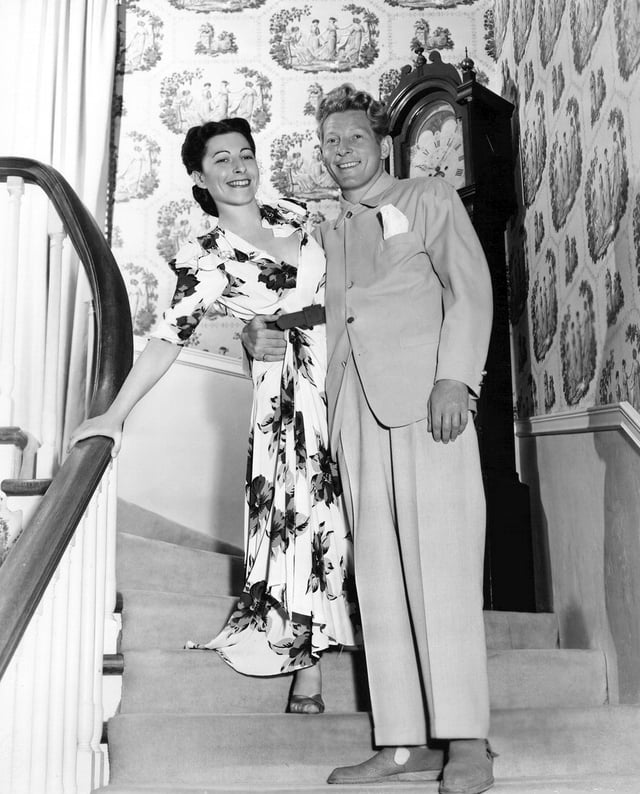
Sylvia and Danny Kaye, 1945
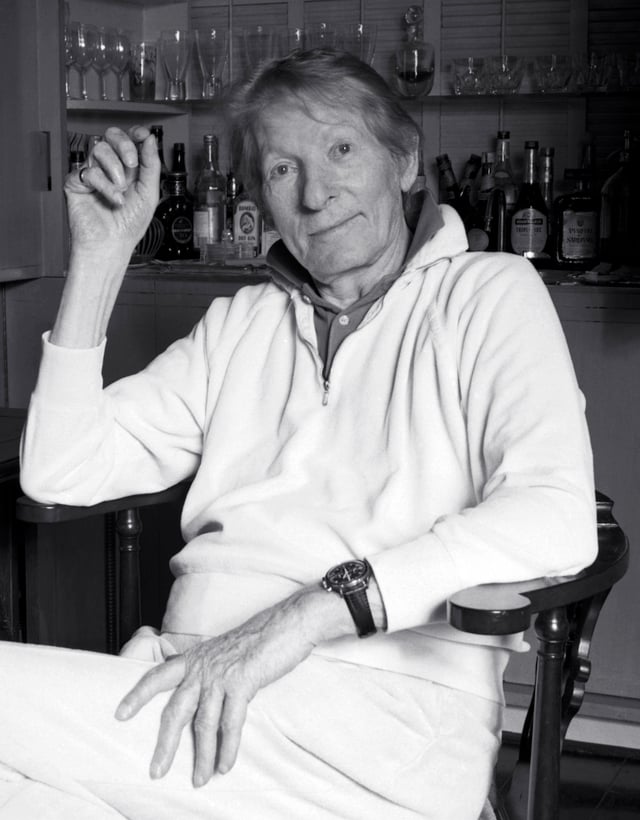
Kaye in 1986 by Allan Warren
Sylvia discovered that Danny had worked for her father Samuel Fine, a dentist.[14] Kaye, working in Florida, proposed on the telephone; the couple were married in Fort Lauderdale[90] on January 3, 1940.[91][92] The couple were married for life except for a separation in 1947 and 1948, when Kaye was involved with Eve Arden.[93]
The couple's only child, daughter Dena, was born on December 17, 1946.[18][94] When she was very young, Dena did not like seeing her father perform because she did not understand that people were supposed to laugh at what he did.[95] Kaye said in a 1954 interview, "Whatever she wants to be she will be without interference from her mother nor from me."[10][70] Dena grew up to become a journalist.[96]
On 18 January 2013, during a 24-hour salute to Kaye on Turner Classic Movies in celebration of what TCM thought was his 100th birthday, Kaye's daughter, Dena, revealed to TCM host Ben Mankiewicz that Kaye's stated birth year of 1913 was incorrect, and that he was actually born in 1911.
A Democrat, he supported Adlai Stevenson's campaign during the 1952 presidential election.[97]
Honors
Kaye was knighted by Queen Margrethe II of Denmark on November 10, 1983. He was awarded the cross of the Knight of the Dannebrog, 1st Class, for his work with UNICEF and longstanding ties with Denmark. Kaye portrayed Hans Christian Andersen in the 1952 film of the same name.[98]
Chevalier of the French Legion of Honor on February 24, 1986, for his work for UNICEF.[1]
On June 23, 1987, Kaye was posthumously presented with the Presidential Medal of Freedom by President Ronald Reagan. The award was received by his daughter Dena.[99][100]
In 1988, Kaye was posthumously inducted into the American Theater Hall of Fame.[101]
UNICEF created the Danny Kaye International Children's Award in his honor, a children's European singing competition shown every year between 1988 and 1992 hosted by Audrey Hepburn and Roger Moore.
Awards and other recognition
Golden Globe Award for Best Actor – Motion Picture Musical or Comedy in 1951, for On the Riviera
Golden Globe Award for Best Actor – Motion Picture Musical or Comedy in 1958, for Me and the Colonel
Lions Clubs International The first recipient of the Lions Clubs International Foundation's Humanitarian Award. (1973–74) [102]
Jean Hersholt Humanitarian Award (1981)
Asteroid 6546 Kaye
Three stars on the Hollywood Walk of Fame; for his work in music, radio, and films[103]
Kennedy Center Honor (1984)
Grand Marshal of the Tournament of Roses Parade (1984)
The song "I Wish I Was Danny Kaye" on Miracle Legion's 1996 album Portrait of a Damaged Family
UNICEF's New York Visitor's Centre is named to honor Danny Kaye.[104]
In December 1996, the PBS series American Masters aired a special on Kaye's life.[105]
A street in the San Antonio, Texas, neighborhood Oak Hills Terrace (located in the city's northwest) is named after Danny Kaye.[106] The neighborhood was established in the late 1960s.[107]
The careers of Kaye and Fine are immortalized in The Danny Kaye and Sylvia Fine Collection at the Library of Congress. The materials preserved in the collection include manuscripts, scores, scripts, photographs, sound recordings, and video clips.[108]
On June 9, 1986, Danny Kaye was crowned King of Brooklyn at the Back to Brooklyn Day Festival. Danny Kaye was there to accept his crown.[109]
Filmography
Film
| Title | Year | Role | Director | Co-stars | Filmed in |
|---|---|---|---|---|---|
| Dime a Dance | 1937 | Eddie | Al Christie | Imogene Coca, June Allyson | Black and white |
| Getting an Eyeful | 1938 | Russian | Al Christie | Charles Kemper, Sally Starr | Black and white |
| Cupid Takes a Holiday | 1938 | Nikolai Nikolaevich (bride-seeker) | William Watson | Douglas Leavitt, Estelle Jayne | Black and white |
| Money on Your Life" | 1938 | Russian | William Watson | Charles Kemper, Sally Starr | Black and white |
| Up in Arms | 1944 | Danny Weems | Elliott Nugent | Dinah Shore, Dana Andrews | Technicolor |
| I Am an American[110] | 1944 | Himself | Crane Wilbur | Humphrey Bogart, Gary Gray, Dick Haymes, Joan Leslie, Dennis Morgan, Knute Rockne, Jay Silverheels | Black and white |
| Wonder Man | 1945 | Edwin Dingle/Buzzy Bellew | H. Bruce Humberstone | Virginia Mayo, Vera-Ellen, Steve Cochran | Technicolor |
| The Kid from Brooklyn | 1946 | Burleigh Hubert Sullivan | Norman Z. McLeod | Virginia Mayo, Vera-Ellen, Steve Cochran, Eve Arden | Technicolor |
| The Secret Life of Walter Mitty | 1947 | Walter Mitty | Norman Z. McLeod | Virginia Mayo, Boris Karloff, Fay Bainter, Ann Rutherford | Technicolor |
| A Song Is Born | 1948 | Professor Hobart Frisbee | Howard Hawks | Virginia Mayo, Benny Goodman, Hugh Herbert, Steve Cochran | Technicolor |
| It's a Great Feeling | 1949 | Himself | David Butler | Dennis Morgan, Doris Day, Jack Carson | Technicolor |
| The Inspector General | 1949 | Georgi | Henry Koster | Walter Slezak, Barbara Bates, Elsa Lanchester, Gene Lockhart | Technicolor |
| On the Riviera | 1951 | Jack Martin/Henri Duran | Walter Lang | Gene Tierney, Corinne Calvet | Technicolor |
| Hans Christian Andersen | 1952 | Hans Christian Andersen | Charles Vidor | Farley Granger, Zizi Jeanmaire | Technicolor |
| Knock on Wood | 1954 | Jerry Morgan/Papa Morgan | Norman Panama Melvin Frank | Mai Zetterling, Torin Thatcher | Technicolor |
| White Christmas | 1954 | Phil Davis | Michael Curtiz | Bing Crosby, Rosemary Clooney, Vera-Ellen, Dean Jagger | VistaVision Technicolor |
| The Court Jester | 1956 | Hubert Hawkins | Norman Panama Melvin Frank | Glynis Johns, Basil Rathbone, Angela Lansbury | VistaVision Technicolor |
| Merry Andrew | 1958 | Andrew Larabee | Michael Kidd | Salvatore Baccaloni, Pier Angeli | CinemaScope Metrocolor |
| Me and the Colonel | 1958 | Samuel L. Jacobowsky | Peter Glenville | Curt Jürgens, Nicole Maurey, Françoise Rosay, Akim Tamiroff | Black and white |
| The Five Pennies | 1959 | Red Nichols | Melville Shavelson | Barbara Bel Geddes, Louis Armstrong, Tuesday Weld | VistaVision Technicolor |
| On the Double | 1961 | Private First Class Ernie Williams/General Sir Lawrence MacKenzie-Smith | Melville Shavelson | Dana Wynter, Margaret Rutherford, Diana Dors | Panavision Technicolor |
| The Man from the Diners' Club | 1963 | Ernest Klenk | Frank Tashlin | Cara Williams, Martha Hyer | Black and white |
| The Madwoman of Chaillot | 1969 | The Ragpicker | Bryan Forbes | Katharine Hepburn, Charles Boyer | Technicolor |
Television
Autumn Laughter (1938) (experimental telecast)
The Secret Life of Danny Kaye (1956) (See It Now special)
An Hour With Danny Kaye (1960 and 1961) (specials)
The Danny Kaye Show with Lucille Ball (1962) (special)
The Danny Kaye Show (1963–1967) (series)
The Lucy Show: "Lucy Meets Danny Kaye" (1964) (guest appearance)
Here Comes Peter Cottontail (1971) (voice)
The Dick Cavett Show (1971) (interview guest)
The Enchanted World of Danny Kaye: The Emperor's New Clothes (1972) (special)
An Evening with John Denver (1975) (special)
Pinocchio (1976) (CBS special); live action television musical adaptation starring Kaye as Gepetto and Sandy Duncan in the title role
Peter Pan (1976) (NBC special); live action television musical adaptation starring Mia Farrow in the title role, and Kaye as Captain Hook
The Muppet Show (1978) (guest appearance)
Disneyland's 25th Anniversary (1980) (special guest appearance)
An Evening with Danny Kaye (1981) (special)
Skokie (1981) (television movie)
"The Wonderful World of Disney" Official Opening of Epcot Center television special (1982) (host and conductor)
The Twilight Zone: "Paladin of the Lost Hour" (1985) (guest appearance)
The Cosby Show: "The Dentist" (1986) (guest appearance)
Stage work
The Straw Hat Revue (1939)
Lady in the Dark (1941)
Let's Face It! (1941)
Two by Two (1970)
Selected discography
Studio albums
Danny Kaye (Decca, 1949)
Danny Kaye Entertains (Columbia, 1950)
Mommy, Gimme a Drinka Water (Orchestration by Gordon Jenkins) (Capitol, 1958)
The Five Pennies (with Louis Armstrong, London, 1959)
Soundtracks
Hans Christian Andersen (1952)
Knock on Wood (Decca, 1954)
Court Jester (Brunswick, 1956)
Merry Andrew (1958)
Spoken word
Danny Kaye for Children (Coral, 1959)
Danny Kaye Tells 6 Stories from Faraway Places (Golden, 1960)
Compilations
Selections from Irving Berlin's White Christmas (1954)
Two by Two (Columbia, 1970)


